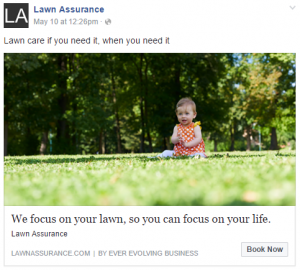
Background
Maybe you call it an only child syndrome, but one of the personalities in my head is always talking. It’s always racing. Sometimes its about nothing what-so-ever, such as the on-going question as to why the Orioles can never seem to have any quality starting pitching. But every once in awhile, it stumbles onto an idea that I think I can make some money off of. One day last year I was wondering why there are so many landscaping companies. And the obvious answer there is, its a low barrier of entry. It’s not overly expensive nor is there a high level of technical difficulty.
Then I got to thinking, what could these companies do that would set themselves apart. Seeing as the entire world is turning to “as a service” products (Uber is a prime example – Uber provides drivers as a service), I was wondering if there was a market for lawn care as a service. So, I started talking to a few contacts that I had that provided various lawn services, and developed a basic premise for my business. With the basic premise in mind, I rounded up a partner or two, formed Lawn Assurance, and set out to build my Minimal Viable Product (MVP).
Minimal Viable Product
The idea with any MVP, is simply to prove the validity of your idea. I identified my MVP as a simple one-page site that laid out what my idea was about. I attempted to highlight the benefits the customer would gain (more free time, peace of mind, etc), and then I created a simple form using JotForms to sign people up to subscriptions. And within the course of a couple weekends, I had found a template, cropped the pictures, scripted the text, purchased the domain, and I had my MVP.
Side note, If this is the first time you are hearing about this idea of an MVP, or you are still fuzzy on this concept, do yourself a favor and go to Amazon and order The Lean Startup: How Today’s Entrepreneurs Use Continuous Innovation to Create Radically Successful Businesses. I could go into further detail, but honestly, I could never do it justice the way Eric Ries does. Great, life altering, book.
Marketing my MVP
And then, as I have previously made a case for marketing on this website, I came up with a very simple and brief marketing plan to promote my service. As this was a Proof of Concept, I only opened it up to residence of Arlington, VA. So, I used Facebook to target specific people within the Arlington area code. Below is an example of one of my ads:

And as you can see from the metrics captured from Google Analytics, my advertisement campaign worked. I took a brand new website, that didn’t exist, and with $50/week in ads, I drove 138 users to it.

And, in what can only be described as the single biggest BUMMER in my life, not a SINGLE one of those 138 users signed up.
Where it went wrong
While I never expected my initial MVP to set the world on fire, zero sign ups wasn’t what I had in mind either. So where did it go wrong? Well, even though I was the one that designed both the MVP and the Ad campaign, I didn’t design them together. What do I mean by that…
There are always going to be gaps in your initial MVP. As Mr. Ries points out in his book, the quicker you get through the “Build-Measure-Learn” cycle, the sooner you can build a product that people actually want. Well, my background is in desktop development, so I built the MVP designed for a user sitting behind a computer. Today, all well designed websites take a “mobile-first” strategy as a majority of users visit websites from phones or tablet. Instead of embracing this reality, I ignored it and decided to take an ostrich approach and stick my head in the sand. As you can see from the screen shots below, my MVP did not translate well to the mobile platform.
Now, the real issue with that, isn’t that I ignored commonly-accepted best practices. That’s stupid, but that’s stupid on the level of “I stubbed my toe in the dark because I was too lazy to turn on the lights.” The spectacularly stupid thing I did was my marketing campaign DROVE people to flaw in my MVP. If you look a little bit deeper into the Google Analytics, you’ll see that 85% of my users came to my website via a mobile Operating System (Android/iOS).

So, while I was able to get 138 new eye balls on my MVP, about 117 of the 138 were looking exactly where I didn’t want them to look. That level of stupidity ranks up there with lighting up a smoke on the Hindenburg…or trying to do a cannonball into a frozen pool.
Nothing else to say here besides lesson learned. As Lawn Assurance 2.0 is being developed, my MVP is being designed with current best practices, and more importantly my marketing strategy, in mind. The good news is, as I’ve been following the principles outlined by Mr. Ries, I’m only out the month of May and about $150. Which, all things considered, is a small price. And, since I know that my advertising campaign has proven effective, I am farther along then when I started. Moving forward, I can focus my time be on refining my message and how it is presented.
And with any luck, I might even be able to get a client or two out of the next 138 people that come to my website…

